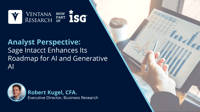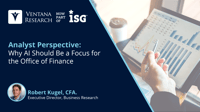Rebalancing supply chains to improve resiliency has been a focus of enterprises with even moderately complex and long supply chains for the past four years. One aspect of this rebalancing is that it almost always involves higher costs. Volume discounts and bargaining power are reduced when more suppliers are used, or an alternate supplier may have higher factor costs and therefore must charge more. Logistics costs might increase, and when an enterprise moves from just-in-time to just-in-case...
Read More
Topics:
Continuous Planning,
Business Planning,
Operations & Supply Chain,
Continuous Supply Chain & ERP
Oracle held an industry analyst summit recently where the focus was on artificial intelligence (AI) and embedded AI. At the event, Oracle demonstrated progress in adding useful AI-enabled capabilities to its business applications, especially in finance and accounting, supply chain, HR and revenue management. To put this into context, across the software industry, AI is already at work in many finance-focused applications that are currently available, albeit often in limited release. We are in...
Read More
Topics:
Office of Finance,
Analytics,
Business Planning,
ERP and Continuous Accounting,
digital finance,
Generative AI,
AI and Machine Learning,
Procure-to-Pay,
Order-to-Cash,
Consolidate and Close Management
We’re quickly approaching the moment when it becomes clear that artificial intelligence (AI) and generative AI (GenAI) will not be free. As that happens, we will discover who’s willing to pay how much and for what. After nearly 18 months of unlimited use-case fantasizing, it should be obvious that not all the potential applications of AI can be realized over the next three to five years because they fail a cost/benefit test. In theory, AI’s potential is almost limitless, but so far, little...
Read More
Topics:
Office of Finance,
Analytics,
Business Planning,
ERP and Continuous Accounting,
digital finance,
Generative AI,
Procure-to-Pay,
Order-to-Cash,
Consolidate and Close Management
Sage Intacct recently held its annual user conference, and while there were plenty of product announcements and roadmap presentations, my focus here is on the artificial intelligence elements. AI–both predictive and generative–is the most important capability and differentiator in software aimed at finance and accounting departments. Ventana Research asserts that by 2027, almost all vendors of ERP software will incorporate AI to reduce workloads, speed processes and decrease errors.
Read More
Topics:
Office of Finance,
Business Planning,
ERP and Continuous Accounting,
digital finance,
Purchasing/Sourcing/Payments,
Consolidate/Close/Report
After a year of near-constant AI chatter, the broad strokes of how the technology will roll out in business over the next three to five years are coming into place. It’s almost trite but worth repeating that artificial intelligence will drive a substantial boost in productivity as it’s adopted. Rather than making large swathes of jobs obsolete, it will take the robotic work out of those job descriptions, enabling people to focus on tasks with a greater economic return.
Read More
Topics:
Office of Finance,
Business Planning,
ERP and Continuous Accounting,
AI,
digital finance,
Generative AI,
Procure-to-Pay,
Order-to-Cash,
Consolidate and Close Management
With a year of AI-everywhere-all-the-time chatter now in the rearview mirror, finance and accounting department executives appear to be in a state of apprehension and well-tuned skepticism about the impact this technology will have on their organization. There are solid reasons to believe that the next few years will be transformative, making it important for departments to adopt a fast-follower approach to artificial intelligence. Rather than being a laggard, leaders must be ready to take...
Read More
Topics:
Office of Finance,
Business Planning,
ERP and Continuous Accounting,
digital finance,
Procure-to-Pay,
Order-to-Cash,
Consolidate and Close Management
We live in an era of uncertainty, not unpredictability. Managing in uncertain times is always difficult, but tools are available to improve the odds for success by making it easier and faster to plan for contingencies and scenarios. Software makes it possible to manage ahead of any future event, connecting the tactical trees to the strategic forest. The purpose of planning is not just to create a plan: Enterprises spend time thinking ahead because it enables leadership teams, executives and...
Read More
Topics:
Office of Finance,
Continuous Planning,
Data Management,
Business Planning,
data operations,
digital finance,
AI and Machine Learning
Digitally transforming finance operations has been a priority since 2020. For purchasing and the procure-to-pay cycle, software can streamline processes, shorten process times, reduce unnecessary costs, provide greater visibility into cash flows, increase control and improve results. Digitizing operations helps attract and retain the best talent because professionals spend less time on mechanical, repetitive tasks. For all these reasons, beginning this year, Ventana Research’s Office of Finance...
Read More
Topics:
Office of Finance,
Continuous Planning,
Business Planning,
digital finance,
supplier relationship management,
Continuous Supply Chain & ERP,
Generative AI,
Procure-to-Pay
Ventana Research recently announced its 2024 Market Agenda for the Office of Finance, continuing the guidance we have provided since 2004 on the practical use of technology for the finance and accounting department. Our insights and best practices aim to enable enterprises to operate with agility and resiliency, improving performance and delivering greater value as a strategic partner.
Read More
Topics:
Office of Finance,
Business Planning,
ERP and Continuous Accounting,
digital finance,
Consolidate/Close/Report
The recent launch of the AI Alliance, a coalition of more than 50 corporations and research institutions engaged in artificial intelligence (AI) development (including AMD, CERN, Cornell University, Dell Technologies, IBM, Intel, Linux Foundation, Meta, NASA, Oracle, ServiceNow and Sony Group), aims to achieve the following objectives:
Read More
Topics:
Office of Finance,
Business Planning,
Enterprise Resource Planning,
ERP and Continuous Accounting,
digital finance,
Revenue, Lease and Tax Accounting,
Purchasing/Sourcing/Payments,
Consolidate/Close/Report,
Continuous Supply Chain & ERP



















